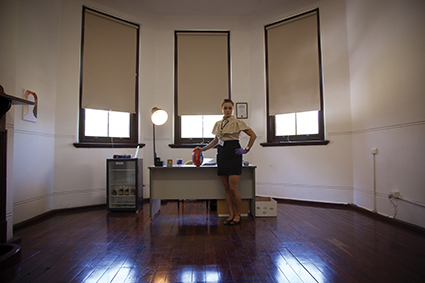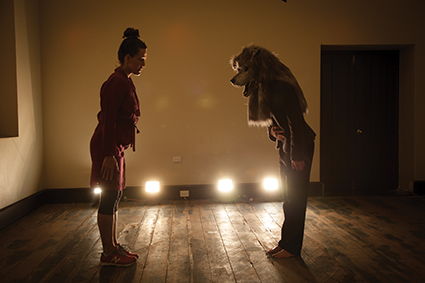Intimate delights and dark disturbances
Nerida Dickinson: Proximity Festival 2014

Tarryn Ruukel, The Queue
photo Peter Cheng
Tarryn Ruukel, The Queue
HELD AT THE FREMANTLE ARTS CENTRE, THE WARREN-LIKE STRUCTURE OF SANDSTONE, COURTYARDS AND GARDENS OF A RE-PURPOSED MENTAL ASYLUM, THIS YEAR’S PROXIMITY FESTIVAL MICRO-PERFORMANCES TAKE FULL ADVANTAGE OF THE VENUE’S HISTORY, QUIRKS AND HIDDEN CORNERS. PERFORMANCES HAVE BEEN THEMATICALLY CURATED INTO GROUPS OF FOUR EACH FOR PROGRAMS A, B AND C, EASILY FOUND WITH THE AID OF THE UNIQUE GUIDING PROGRAM FOR EACH PARTICIPANT, COMPLETE WITH A MARKED VENUE MAP, AND THE STRATEGICALLY LOCATED, HELPFUL USHERS. TIMEKEEPING IS ENFORCED BY A SYSTEM OF HANDBELLS, RUNG PRECISELY ACROSS THE SITE TO SIGNAL THE START AND END TIMES OF EACH PIECE.
Program A is the top pick for anyone unfamiliar with one-on-one performance. It’s full of new experiences, providing plenty of interesting moments to share afterwards—learning to twerk, teaching someone to drive, crafting a clitoris out of sweets and undergoing an interview for the right to stay in Australia. Each of these presentations delivers more than its basic premise, but the standout work is Toyi-Toyi Theatre’s The Queue where you are reduced to just another item on the list of tasks for the presenter to process, the emotional challenge amplified by its contrast with the friendly interactions with other presenters in the program.
By the door is a stack of clipboards, with pens. On the bell, I obediently fill in a government-style form, only to be interrupted by the door opening and an impatient Tarryn Runkel telling me to skip through it but to pay attention to the last page and sign my acceptance of the condition that to fail this Right to Stay interview will result in deportation to my “home country” without the right to see my friends or family here again. I sign. I am tested on my knowledge of Australian history, slang and how to pass in Aussie Rules football. Physical tests include arbitrary complexion and hair inspection, the piece climaxing with a modern version of the notorious dictation test before the inevitable stamping with “DEPORTED” and brisk removal out the door. The personal and political merge, my sensation of helplessness and outraged reaction exacerbated when I realised that the relief I felt at having failed stemmed from racist assumptions.
Program B is the choice for the thoughtful participant, open to new ideas and challenges to engage in mindful activities. Experiences encompass a workout session completed while sharing a specially designed suit with the trainer, an invitation to embark on an emotional fast, a dialogue in the language of flowers and an intimate experiment in generating oxytocin. Each piece requires full engagement to be effective, and each continues to provide food for thought long after the final bell.
Of this program, Tetherweight (for Adrian Howells) stands out as the most challenging work, an antithesis of traditional performance in its demands for an introspective response from each audience member, and yet perfectly executed in this celebration of one-on-one performance. The initial knocking at the door, the soothing music selection, James Berlyn’s gentle voice in the darkness and a heaped pile of clocks all create a waking dream. The carefully scripted text, with its references to “the swing,” makes it natural to move onto the tilted gym equipment, which is set in motion in pitch blackness. The swing, unobtrusively evoking emotional states with its movement, creates a sensation of weightlessness while simultaneously combining the comfort of a cradle and the thrill of a rollercoaster. Moving to a quiet space to write, I accept the invitation to record what triggers strong positive and negative emotions in me and to place it in an envelope as a gift to my future self. Accepting Berlyn’s proposal to commence an emotional fast, I leave with an anklet gently offered to mark its beginning. I am feeling incredibly refreshed and a little dream-laden, as after deep meditation.
Program C has most to offer to those accustomed to one-on-one performance, happy to dive deep into its potential for surrealism. All pieces play on sensation and perception, with a bar offering tastings of air from different eras, a physical challenge to attempt tasks while deprived of selected evolutionary advantages, wafts of scent unfolding an unsolved mystery and a bombardment of words travelling through time before the entry of a surprise dance partner.

Dance with Me
photo Peter Cheng
Dance with Me
Each of Program C’s presenters show mastery of the intimacy and mind manipulation possible with a single audience member, but Dance with Me amazes on two fronts. Sylvia Rimat creates an intimate experience without being physically present, and then shocks me by introducing a dancing wolf.
I enter a sparsely furnished room, dismissing the disembodied voice that greets me on entry as a recording, until it describes my physical appearance. Following the voice’s instructions, I find myself performing innocuous tasks such as sitting at a table, adjusting a light and pouring water. Pressing ‘play’ on a cassette recorder introduces overlapping voices: instructions together with descriptions of people from bygone times in an increasingly dense and hallucinatory auditory experience. As I obediently feel the texture of a wall and read a note about hot shrimp from a pile of crumpled pages, suddenly the measured voice of a man is twinned with the order to pick up a glass and break it over his head. More voices crowd in, filling the empty room lit only by a table lamp, before a blast of music and flare of light from hitherto unnoticed stage lights. A side door opens and a slim figure, bearing the head and neck of a wolf, lightly dances its way in front of the lights before standing by me, inviting me to dance. We take simple steps, gradually moving into an old fashioned waltz, the bulging plastic eyes of the mask looking deeply into my eyes with an odd sense of intimacy.
The music ends, the wolf bows and leaves, the lights fade and a bell rings… I leave the room and its whispers to return to the calm ushers and excited participants mingling in the corridors.
–
Proximity Festival 2014, co-curator, producer Sarah Rowbottam, co-curator Kelli Mccluskey, artists James Berlyn, Caroline Garcia, Jen Jamieson, Cat Jones, Loren Kronemyer, Tanya Lee, Emily Parsons-Lord, Sylvia Rimat, Hallie Shellam, Ian Sinclair, Alina Tang and Toyi-Toyi Theatre; Fremantle Arts Centre, Fremantle, 22 Oct-2 Nov
RealTime issue #124 Dec-Jan 2014 pg. 20






